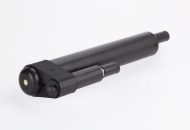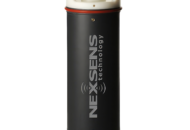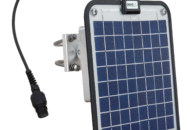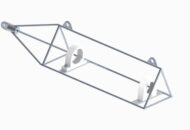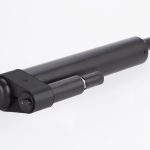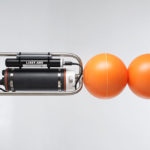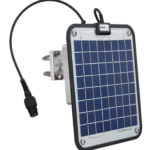FAQ
Why is there a problem with turbidity?
The sensitivity (Volts/[mg/L] ) of optical turbidity sensors varies inversely with grain size. Turbidity sensors are highly sensitive to fine particles, and insensitive to large particles.
For a constant concentration, a turbidity sensor will show a large response to fine particles (e.g. 5 µm), and – for the same concentration – a much smaller response to larger particles, e.g. 75 µm. To calibrate a turbidity sensor to suspended sediment concentration one must therefore know the grain-size, or assume that it doesn’t vary.
Want more detail? Read this paper: Bundgaard K, Lumborg U, Nyborg L, Jakobsen BH (2019): Challenges of optical backscatter monitoring in mixed sediment environments. Terra et Aqua 154: 22-28, which you can download here (external link) – pay particular attention to Figure 2 in the paper.
How does the LISST-AOBS solve the problem with turbidity?
The sensitivity (Volts/[mg/L] ) of optical turbidity sensors varies inversely with grain size. Turbidity sensors are highly sensitive to fine particles, and insensitive to large particles.
The LISST-ABS has a nearly constant sensitivity (Volts/Concentration) for particles larger than about 30 µm, out to about 500 µm. Below about 30 µm, LISST-ABS response is also size dependent: relatively insensitive to fine particles, and sensitive to large particles – the opposite of optical turbidity.
The combination of acoustics and optics, when done properly, compensates these opposite tendencies of change with grain size, and produces a system that is substantially (but not totally) independent of grain size variations in this range.
What are the benefits of the LISST-AOBS?
Because of the near-constant calibration for the LISST-AOBS Super-Turbidity sensor, the measurements of suspended sediment concentration are far more accurate, over a wide grain size range, than either turbidity (optical backscatter) or LISST-ABS (acoustic backscatter) individually.
Due to size dependence, individual calibration of the turbidity and LISST-ABS sensors is normally required when operating alone. Because of the fixed calibration achieved by the combination of ‘paired’ LISST-ABS and turbidity sensors, the need for calibration of either sensor is greatly reduced. This is a major convenience to experimentalists!
Can I combine past data that I already have?
YES!
If you have concurrent, historical LISST-ABS and turbidity data you can combine them into one. A single patent pending calibration method finds a critical weight factor that then is used to combine past data. The step involves obtaining one measurement of sensitivity of the optical turbidity sensor at a given grain size (30 µm). A weight factor is found as the ratio of LISST-ABS output and turbidity sensor output. This weight factor then allows the weighted sum of the two instrument outputs, thus correcting past data also.
How does it work?
From the calibration of the turbidity, the response (Volts/[g/L]) is measured for 30 µm particles. A weight factor is computed using this value. The two outputs – LISST-ABS and turbidity – are combined with this weight factor applied to the turbidity data, resulting in the Super-Turbidity data. The figure below shows the sensitivity of the optical turbidity and LISST-ABS, working alone, and after weighted addition.
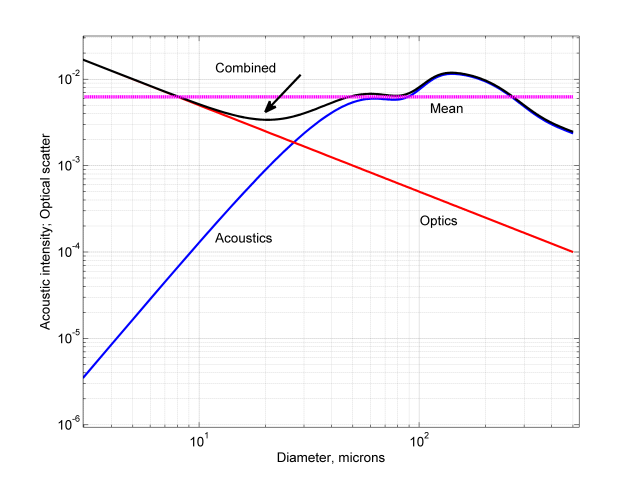
The COMBINED response (black) from the LISST-AOBS as a function of grain-size, compared with the response from OBS (red) and LISST-ABS (Blue).
How well does it work?
The figure below shows the sensitivity of a LISST-ABS and a turbidity sensor for a wide range of narrow grain sizes (in legend) and powders from PTI. Combining the two produces the LISST-AOBS Super-Turbidity Meter output. It is evidently that the combined results are substantially improved over either technology. If not combined, the individual technologies produce errors of a factor of ~100. When combined, the errors are within a factor of ~2.
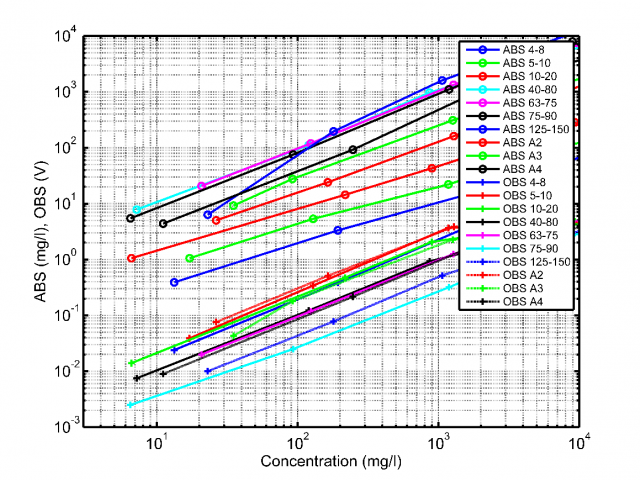
ABS and OBS responses to changing concentrations and grain-sizes
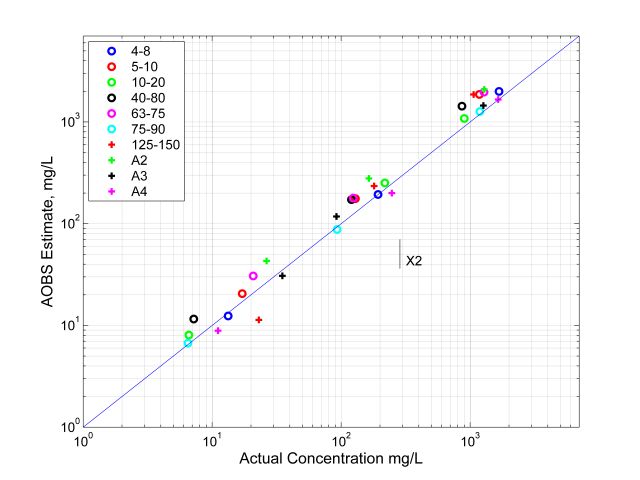
LISST-AOBS vs actual sediment concentration for a range of sediment grain-sizes.
Is the LISST-AOBS a method or an instrument?
Both!
Sequoia has applied for a patent on the methodology and method whereby one can ‘pair’ concurrent data from a LISST-ABS and any turbidity sensor. This will give the user the combined output, the AOBS data.
Sequoia also offers an instrumentation package, called the LISST-AOBS. This package is made up of a standard LISST-ABS and a Turner Designs Turbidity Plus(TM) turbidity sensor. The instrumentation package is delivered as a turnkey system with the two sensors fully paired by Sequoia, and includes a bracket and Y-cable for powering and combining the signal from the two sensors into a unified SDI-12 output. Nexsens data loggers are available as accessories from Sequoia.
Does Sequoia offer to pair other turbidity sensors with the LISST-ABS?
No.
Sequoia will not pair the LISST-ABS with any other turbidity sensor than the TurbidityPlus sensor from Turner Designs.
Users can purchase the complete, paired LISST-AOBS instrumentation package, consisting of a LISST-ABS integrated with a Turner Designs TurbidityPlus(TM) sensor from Sequoia. This is the only combined package Sequoia offers for sale.
Users who wish to use another turbidity sensor must provide their own cabling, wiring, data logger(s), and do the pairing between their LISST-ABS and turbidity sensor themselves.
How do I do the pairing?
You don’t need to do the pairing if you buy the complete instrumentation package from Sequoia.
If you have your own turbidity sensor and you want to pair it with a LISST-ABS, Sequoia offers for sale a license that includes a vial of particles designed for pairing, including written instructions.
Is the TurbidityPlus sensor calibrated to NTU?
No.
- The TurbidityPlus sensor is NOT calibrated to NTU. The output from the TurbidityPlus sensor is in V only.
- Please note that
- It is completely irrelevant for the pairing of the two sensors if the TurbidityPlus is calibrated to NTU or not.
- Sequoia will not offer NTU calibration of the TurbidityPlus sensor. The customer is responsible for any NTU calibration.
- The Turner Designs TurbidityPlus manual provides instructions on how to calibrate the sensor to NTU if desired.
What data loggers work with the LISST-AOBS?
- Any SDI-12 enabled data logger will work with the LISST-AOBS.
- The LISST-AOBS will output ABS data, turbidity sensor data AND the paired data in a single datastream.
- Sequoia recommends the Nexsens X3 data logger for the LISST-AOBS.
Can I rent the LISST-AOBS?

